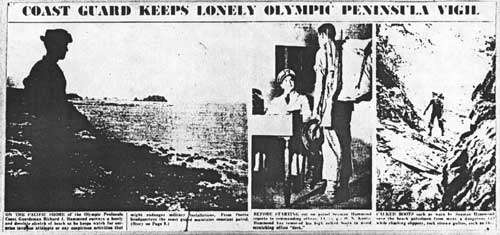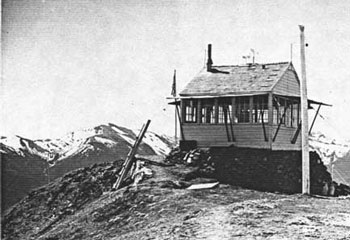The strategic location of Olympic National Park on the Olympic Peninsula led the Coast Guard to set up multiple coast guard stations in what is now Olympic National Park. Two former coast guard structures still exist Of the thirteen Aircraft Warning Service lookouts once in use, only two survive to remind visitors of the frightened and earnest efforts made at coastal defense in the earliest days of World War II.
Defending the Olympic Peninsula

Olympic National Park
At the outbreak of World War II, many military personnel considered the Olympic Peninsula one of the most threatened and vulnerable parts of the contiguous United States. Forming the southern edge of the Strait of Juan de Fuca, the Olympic Peninsula is located at the entrance to one of two principal inland waterways extending from the Pacific Ocean to strategically important Northwest coastal cities. The large ports of Seattle and Tacoma and the U.S. naval base and shipyard at Bremerton are accessed by the Strait of Juan de Fuca. Projecting further west into the Pacific Ocean than any other land mass in the lower 48, the Peninsula is the "leading edge," first to feel the effects of attack from an alien country approaching the U.S. from the west. In addition, the geographic isolation, rugged terrain and adverse climate of the Peninsula are factors that impeded terrestrial defense measures.
Much of the rugged coastline occupied by the Coast Guard in the Port Angeles area is now included in the Coastal Strip of Olympic National Park.
Ozette Lake Coast Guard Station
At the height of coast guard activity in the Ozette Lake section, ten beach patrol outposts and three coastal lookout towers were in operation. Beach patrol outposts, the lookouts and the patrol station at Ozette Lake stayed in touch with each other via trails, either along the beach or through the woods, telephone lines, and fixed or portable radios.
At the Ozette Lake Coast Guard Station, a total of forty dogs and ten dog handlers. This was the largest contingent of dogs of any coast guard station on the Washington and Oregon coasts.
By 1942, station personnel had completed several buildings barracks, a storeroom and an armory at the north end of Ozette Lake.. By mid 1943, the complex of coast guard structures at Ozette had grown to two barracks buildings, a galley and mess hall, cook's quarters, two buildings (the "school house" and "Ozetta") for quartering men, ex-officer's quarters, a study and library building, an office building, a storeroom, dog kennels, two boat landings, and an assortment of outbuildings
The activity of the beach patrol units in the Ozette Lake area, as elsewhere in the Pacific Northwest's 13th Naval District, were short lived. By the summer of 1943, the danger of enemy landings on the West Coast declined, and military officials felt that full beach coverage was no longer necessary. On 29 March 1944, beach patrol activities at Ozette Lake were discontinued
Little evidence remains in 1983 of the presence of the coast guard in the Ozette Lake area. At the north end of the lake the former coast guard station mess hall and kitchen is the remaining structure dating from the World War II beach patrol era. It has been altered and converted for administrative purposes. Of the patrol outpost structures, only the small wood frame cabin at Starbuck Creek remains. Remnants of the trail system developed and maintained by the coast guard are still in use between Ozette Lake and the beach, and along Shi Shi Beach.
La Push Beach Patrol Station
Located near or within the present Park boundaries were two U.S. Coast Guard beach patrol stations - the La Push Beach Patrol Station, just outside the park boundary and the Kalaloch Beach Patrol Station was approximately twenty-five miles south of La Push.
By mid June 1943, twenty-eight dogs assisted with the patrolling operations along the beach. Continuous day and nighttime patrols were maintained throughout the La Push area except where cliffs rising abruptly from the ocean made after-dark patrolling hazardous. As part of the Coastal Lookout System, the La Push Beach Patrol unit maintained a lookout tower on James Island and a light station on Destruction Island.
Kalaloch Beach Patrol Station
Adjoining and to the south of the La Push Coast Guard beach patrol unit, the Kalaloch beach patrol unit conducted patrol and lookout activities between Hoh Head and Cape Elizabeth. On 1 October 1942, the U.S. Coast Guard established a beach patrol station in buildings that comprised Becker's Ocean Resort. The forty-two acre coast guard station, located near the mouth of Kalaloch Creek on a low, sandy bluff overlooking the Pacific Ocean, included the main resort lodge, eighteen resort cabins, a store and post office, and several storage and outbuildings. During its one and one-half years of occupancy, the coast guard expanded and adapted the complex of buildings at Becker's to suit the needs of the 140 enlisted men and officers who engaged in beach patrol and lookout activities. The coast guard constructed two barracks buildings, dog kennels and a laundry building at the station.
The beach patrol unit at Kalaloch was divided into nine patrol sections. Patrol outposts were located at Abbey Island, Steamboat Creek, Ashenbrenner, Queets River, Raft River, Hogs Back and Pratt Cliff. The coast guard erected shelter houses in each of the patrol sections and equipped them with two sleeping bags. As elsewhere on the Olympic Peninsula, four patrolmen were on each patrol section at all times—two at the shelter house and two actively engaged in patrol activities.
In the Kalaloch beach patrol section little trace of the coast guard remains. There are no outpost cabins known to exist. Becker's Ocean Resort, now Kalaloch Lodge, has experienced numerous changes since World War II. Most of the resort cabins used by the coast guard have been replaced by newer units. The barracks, mess hall and dog kennels at Kalaloch Beach Patrol Station are no longer standing.
Olympic's Aircraft Warning Service Stations

Courtesy of Ellis Studio and Post Card Co.
In addition to the beach patrol and lookout activities performed by the U.S. Coast Guard in 1942 and 1943, several coast guard posts on the Olympic Peninsula coastline assisted with the Aircraft Warning Service operation. In the spring of 1943, several coast guard posts took responsibility for sighting and reporting enemy aircraft. Aircraft Warning Service lookout posts were located at Tatoosh Island, Ozette, Cape Alava, Quillayute River, Kalaloch, Whale River and Destruction Island (FARC 1943, 8 March).
During the winter of 1942-1943, a total of thirteen Aircraft Warning Service observation posts located in the present Olympic National Park provided twenty-four hour surveillance. Already existing structures called into service for AWS purposes included Dodger Point, Deer Park and Hurricane Ridge fire lookouts and the Enchanted Valley Chalet. New structures used specifically for AWS observation were erected at Pyramid Peak, Warkum Point, Indian Pass and Geodetic Hill. Only two structures in the Park utilized by AWS personnel during World War II are extant in 1983: Dodger Point lookout and Pyramid Peak lookout.
The Park Service assisted with Aircraft Warning Service operations in myriad ways during the one and one-half years of AWS existence. In the early months of aircraft observation activity, the Park Service furnished cots, CCC trucks (and sometimes CCC enrollees), tractors, men, and maps showing the topography of the Park and surrounding areas on the Olympic Peninsula. Park Service personnel constructed and cleared roads and trails to provide AWS observers clear access to lookout posts. They laid and maintained telephone lines where none previously existed. In some cases, the Park constructed AWS lookout towers.
The Park's ranger force often devoted much of their time to transporting supplies to remote lookouts in the interior of the Park. During the stormy winter months of 1942 and 1943, considerable effort was expended in this endeavor. In the waning months of 1942 the Park superintendent's monthly report described the Park's efforts to transport supplies to Hurricane Ridge lookout: "All supplies are tobogganed over three miles of difficult terrain to Hurricane Lookout. It required two days and six men to get all supplies in. Eight men back-packed 400 pounds of supplies six miles in order to establish observers on a distant lookout in the Park area".
On June 1, 1944 the entire AWS system was abandoned along the Pacific Coast, and all personnel were laid off.
Olympic's Contribution
Throughout the four years of U.S. involvement in World War II, and especially during the time of military defense activities on the Olympic Peninsula, Olympic National Park cooperated with all the branches of the armed forces in numerous subtle yet significant ways. Within the Coastal Strip and the Queets Corridor, then known as the Olympic acquisition area, the Park Service issued special use permits for coast guard and army use of Becker's Ocean Resort, Ruby Beach Resort, Thunderbird Inn at the Washburn Resort, C. W. Keller's Resort (located in the Coastal Strip), and Kelley's Ranch (on the Queets River). On the boundary of the Park's Morse Creek addition the Park Service issued the army a special use permit for the designation of an "Impact and Hazard Area" in connection with army tank gun target practice. On the coast the Park granted permission for the removal of 130,000 tons of sand from Rialto Beach for use in completing the Quillayute Air Base.
On many occasions during the war personnel from both the military and the Park Service exchanged services on various missions. Olympic National Park personnel instructed groups of military men in firefighting techniques, assisted in airplane rescue work and organized recreational trips into the Park. While men of the 15th Cavalry were stationed at Port Angeles, the Park opened the swimming pool at Olympic Hot Springs for their use. On several occasions the U.S. Coast Guard took Park personnel on flights over the Park for study purposes. Both the navy and coast guard supplied the Park with men to fight forest fire. At Olympic National Park, as in other National Parks across the country, park officials and military officials came together for the benefit of all.
Last updated: November 30, 2015
